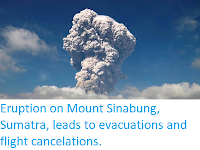The Darwin Volcanic Ash Advisory Centre reported an eruption on Mount Kerinci in West Sumatra, on Sunday 10 June 2018, which produced an ash column that rose to a height of 4 km and drifted to the west. Kerinci ia a stratovolcano (cone shaped volcano made
up of layers of ash and lava), in the Barisan Mountains, which run along the western side of Sumatra. It reaches 3800 m above sealevel, making it the highest point on the island of Sumatra, the second highest point in Indonesia (after Puncak Jaya, a fold mountain in West Papua Province, which forms the highest point on any island in the world) and the second highest island volcano in the world (after Mauna Kea in Hawai'i). It is a fairly active volcano, with frequent small eruptions, though major eruptions are rare, located within the Kerinci National Park, and is a popular tourist attraction.
Mount Kerinci seen from the south in 2008. Wikimedia Commons.
The Indo-Australian Plate, which underlies the Indian Ocean to the west of Sumatra, is being subducted beneath the Sunda Plate, a breakaway part of the Eurasian Plate which underlies Sumatra and neighbouring Java, along the Sunda Trench, passing under Sumatra, where friction between the two plates can cause Earthquakes. As the Indo-Australian Plate sinks further into the Earth it is partially melted and some of the melted material rises through the overlying Sunda Plate as magma, fuelling the volcanoes of Sumatra.
The two plates are not directly impacting one-another, as occurs in the subduction zones along the western margins of North and South America, but at a steeply oblique angle. This means that as well as the subduction of the Indo-Australian plate beneath the Sunda, the two plates are also moving past one-another. This causes rifting within the plates, as parts of each plate become stuck to the other, and are dragged along in the opposing plate's direction. The most obvious example of this is the Sumatran Fault, which runs the length of Sumatra, with the two halves of the island moving independently of one-another. This fault is the cause of most of the quakes on the island, and most of the island's volcanoes lie on it.
The movement of the tectonic plates around Sumatra. NASA/Earth Observatory.
See also...
Follow Sciency Thoughts on Facebook.









